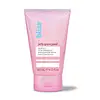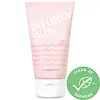What's inside
What's inside
 Key Ingredients
Key Ingredients

 Benefits
Benefits

 Concerns
Concerns

 Ingredients Side-by-side
Ingredients Side-by-side

Water
Skin ConditioningGlycerin
HumectantDiglycerin
HumectantCarbomer
Emulsion StabilisingCetrimonium Chloride
AntimicrobialGlycereth-26
HumectantPanthenol
Skin ConditioningNiacinamide
SmoothingPanthenyl Triacetate
Cocos Nucifera Fruit Extract
EmollientMalus Domestica Fruit Cell Culture Extract
Skin ConditioningPapain
Skin ConditioningBromelain
Skin ConditioningSodium Hyaluronate
HumectantLecithin
EmollientLactobacillus
Skin ConditioningLactobacillus Ferment
Skin ConditioningXanthan Gum
EmulsifyingSaccharide Isomerate
HumectantHydroxypropylcellulose
EmulsifyingCellulose
AbsorbentMaltodextrin
AbsorbentSodium Citrate
BufferingPhenoxyethanol
PreservativeEthylhexylglycerin
Skin ConditioningCitric Acid
BufferingLavandula Angustifolia Oil
MaskingSalvia Officinalis Oil
MaskingPelargonium Graveolens Flower Oil
MaskingLinalool
PerfumingCI 16035
Cosmetic ColorantWater, Glycerin, Diglycerin, Carbomer, Cetrimonium Chloride, Glycereth-26, Panthenol, Niacinamide, Panthenyl Triacetate, Cocos Nucifera Fruit Extract, Malus Domestica Fruit Cell Culture Extract, Papain, Bromelain, Sodium Hyaluronate, Lecithin, Lactobacillus, Lactobacillus Ferment, Xanthan Gum, Saccharide Isomerate, Hydroxypropylcellulose, Cellulose, Maltodextrin, Sodium Citrate, Phenoxyethanol, Ethylhexylglycerin, Citric Acid, Lavandula Angustifolia Oil, Salvia Officinalis Oil, Pelargonium Graveolens Flower Oil, Linalool, CI 16035
Water
Skin ConditioningGlycerin
HumectantCellulose
AbsorbentButylene Glycol
HumectantAlcohol Denat.
AntimicrobialDipropylene Glycol
HumectantPentylene Glycol
Skin ConditioningCeteareth-12
EmulsifyingCitrus Limon Peel Oil
MaskingJuniperus Mexicana Oil
MaskingCitrus Aurantium Dulcis Peel Oil
MaskingCitrus Grandis Peel Oil
MaskingEucalyptus Globulus Leaf Oil
PerfumingLavandula Angustifolia Oil
MaskingRosmarinus Officinalis Leaf Oil
MaskingAloe Barbadensis Leaf Polysaccharides
EmollientPhoenix Dactylifera Seed
Skin Conditioning1,2-Hexanediol
Skin ConditioningTriethanolamine
BufferingPolysorbate 20
EmulsifyingCaprylyl Glycol
EmollientLactose
HumectantHydroxypropyl Methylcellulose
Emulsion StabilisingEthylhexylglycerin
Skin ConditioningJojoba Esters
EmollientHydrogenated Lecithin
EmulsifyingMannitol
HumectantAscorbyl Palmitate
AntioxidantTocopheryl Acetate
AntioxidantCholesterol
EmollientPEG-800
HumectantBromelain
Skin ConditioningPapain
Skin ConditioningAscorbic Acid
AntioxidantSh-Oligopeptide-1
Skin ConditioningSh-Polypeptide-1
Skin ConditioningSh-Oligopeptide-2
Skin ConditioningSh-Polypeptide-22
Skin ConditioningSh-Polypeptide-45
Skin ConditioningSh-Polypeptide-8
HumectantSh-Polypeptide-9
Skin ConditioningCarbomer
Emulsion StabilisingDisodium EDTA
CI 77007
Cosmetic ColorantWater, Glycerin, Cellulose, Butylene Glycol, Alcohol Denat., Dipropylene Glycol, Pentylene Glycol, Ceteareth-12, Citrus Limon Peel Oil, Juniperus Mexicana Oil, Citrus Aurantium Dulcis Peel Oil, Citrus Grandis Peel Oil, Eucalyptus Globulus Leaf Oil, Lavandula Angustifolia Oil, Rosmarinus Officinalis Leaf Oil, Aloe Barbadensis Leaf Polysaccharides, Phoenix Dactylifera Seed, 1,2-Hexanediol, Triethanolamine, Polysorbate 20, Caprylyl Glycol, Lactose, Hydroxypropyl Methylcellulose, Ethylhexylglycerin, Jojoba Esters, Hydrogenated Lecithin, Mannitol, Ascorbyl Palmitate, Tocopheryl Acetate, Cholesterol, PEG-800, Bromelain, Papain, Ascorbic Acid, Sh-Oligopeptide-1, Sh-Polypeptide-1, Sh-Oligopeptide-2, Sh-Polypeptide-22, Sh-Polypeptide-45, Sh-Polypeptide-8, Sh-Polypeptide-9, Carbomer, Disodium EDTA, CI 77007
 Reviews
Reviews

Ingredients Explained
These ingredients are found in both products.
Ingredients higher up in an ingredient list are typically present in a larger amount.
We don't have a description for Bromelain yet.
Carbomer is a polymer of acrylic acid. Its main role is to create a gel consistency.
A high amount of carbomer can cause pilling or balling up of products. Don't worry, most products contain 1% or less of carbomer.
Cellulose is the main component of plant cell walls. It is used as an emulsifier, absorbent, and texture enhancer.
This ingredient has many functions:
Fun fact: Cellulose is the most abundant form of organic polymer on Earth.
Learn more about CelluloseEthylhexylglycerin (we can't pronounce this either) is commonly used as a preservative and skin softener. It is derived from glyceryl.
You might see Ethylhexylglycerin often paired with other preservatives such as phenoxyethanol. Ethylhexylglycerin has been found to increase the effectiveness of these other preservatives.
Glycerin is already naturally found in your skin. It helps moisturize and protect your skin.
A study from 2016 found glycerin to be more effective as a humectant than AHAs and hyaluronic acid.
As a humectant, it helps the skin stay hydrated by pulling moisture to your skin. The low molecular weight of glycerin allows it to pull moisture into the deeper layers of your skin.
Hydrated skin improves your skin barrier; Your skin barrier helps protect against irritants and bacteria.
Glycerin has also been found to have antimicrobial and antiviral properties. Due to these properties, glycerin is often used in wound and burn treatments.
In cosmetics, glycerin is usually derived from plants such as soybean or palm. However, it can also be sourced from animals, such as tallow or animal fat.
This ingredient is organic, colorless, odorless, and non-toxic.
Glycerin is the name for this ingredient in American English. British English uses Glycerol/Glycerine.
Learn more about GlycerinLavandula Angustifolia Oil is more commonly known as lavender essential oil. It is considered a fragrancing ingredient.
Lavender imparts a famous scent. While the smell is lovely, this ingredient and may sensitize skin in topical products. This is because about 85% of the oil is made up of linalool and linalyl acetate.
When exposed to air, these two compounds become strong allergens. This ingredient exhibits cytotoxicity at low concentrations; amounts of 0.25% have been shown to damage skin cells.
A study from Japan found this ingredient caused lavender sensitivity after widespread exposure.
Lavender essential oil has some antimicrobial, antibacterial, and anti-inflammatory properties. However, the cons of this ingredient may outweight the pros.
More research is needed to confirm lavender essential oil's effects when used in aromatherapy.
Lavandula Angustifolia is known as the English Lavender and famous for creating purple fields in Provence, France.
Learn more about Lavandula Angustifolia OilPapain is an enzyme found naturally in the papaya plant's leaves, fruit, and roots. It has antimicrobial, soothing, and wound healing properties.
Glycine and Vitamin A are naturally found in papain.
While papain is often touted as skin-lightening, further studies are needed to prove this. However, papain has been shown to help soothe acne-inflammation.
Papain belongs to a class of enzymes called proteolytic enzymes. These enzymes break down peptides and amino acids.
Some studies found papain to be a potential skin sensitizer and allergen. Those with latex allergies might also be allergic to papaya.
Learn more about PapainWater. It's the most common cosmetic ingredient of all. You'll usually see it at the top of ingredient lists, meaning that it makes up the largest part of the product.
So why is it so popular? Water most often acts as a solvent - this means that it helps dissolve other ingredients into the formulation.
You'll also recognize water as that liquid we all need to stay alive. If you see this, drink a glass of water. Stay hydrated!
Learn more about Water